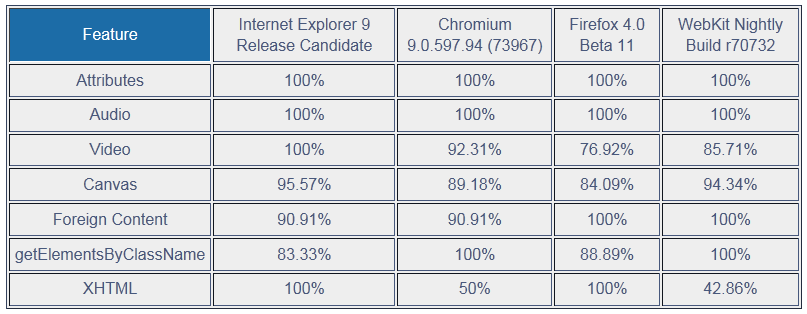HTML 5, Firefox and Internet Explorer
HTML 5 is designed for Web applications. To what extent is it implemented
in major browsers? We shall see that in detail.
Note that a web application does not necessarily need to be compatible with
all browsers, unlike a Web page: you can ask users to use Firefox or IE 3
to 8 use it as they are being asked to install a local software.
New tags for layout
Among new tags described in the working draft of the HTML 5 specification, few are recognized by browsers.
The object tag to integrate images or other media, is implemented by Internet Explorer 8. There is nothing like it in the documentation of Mozilla.
Other minor changes are made. No new tags structure is added.
Storage
Firefox explains in its documentation, how sessionStorage is implemented, and how to use it. A very useful attribute to keep all data supplied by a user while he is connected.
SessionStorage is implemented in Firefox and Internet Explorer 8.
Firefox and Internet Explorer implements also globalStorage, which is not defined in the standard and which does not have the same role. The content of sessionStorage is unique to each user, but globalStorage is shared among all connected users.
- Storage. Mozilla Wiki. Note that so far, the wiki refers to Web Application 1.0, replaced by HTML 5 for a while.
- SessionStorage property.
Offline Mode
Firefox 3 supports the offline mode.
In HTML 5, the offline mode is defined as an application cache, which retains the page and data from the database of the application.
For Google Gears, this application cache is achieved through the use of SQLite, a local equivalent of MySQL or other SQL database, and this is the principle adopted by Firefox.
The offline mode is not added to IE8, Microsoft relying probably on Silverlight.
Canvas
Canvas is totally ignored by Internet Explorer 8. This is normal,
that is a competitor to Silverlight, a proprietary Microsoft technology. The operation of the two objects is close
enough.
The Mozilla site offers many working examples of Canvas, for Firefox.
Cross-site Ajax
Ajax, is not part of HTML 5, but it is extended by a separate specification called Access Control. It seems that it is implemented in Firefox. But Internet Explorer 8 implements a new object, XDomainRequest replacing XMLHttpRequest for data exchange between different websites. This changed again in IE9.
Vidéo and audio
- Firefox supports the video and audio tags from HTML 5.
- Chrome too.
You can, of course, always use the object and embed tags.
Conclusion
Despite the inconsistencies, a major step was taken by the browsers to help
in making Web applications, even if it is not yet what advocates HTML 5, it
is true that this is a standard being defined. Developers must therefore build
modern applications dedicated to a browser, based on Canvas for Firefox
or Silverlight.
In this idea, Firefox 3 allows to run a Web application as a local software
through its integration of Chromeless,
which launches the application when you click on an icon on the desktop.
Références
- HTML 5. Overview.
- HTML 5 Working Draft. By the WHATWG.

HTML 5 compatibility sheet, November 2010, detail on the link above

